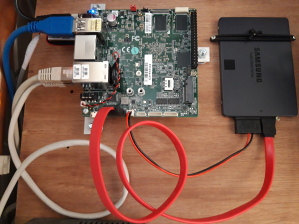
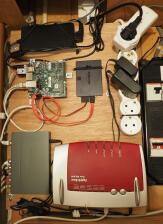
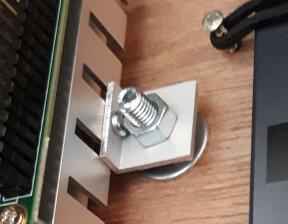
At some point in time another 2TB SSD disk was added to the RAID-1 array of the Jetway based server, adding redundancy
to the old rotational storage. However, the system did not boot reliably anymore unless it was powered off for a couple of minutes. Also
it did not have any decent HDMI or DP connector, only VGA and I wanted to get rid of old hardware. So it slowly became time to replace it. Looking around I noticed the
Odroid H2+ but it was not available due to chip shortages.
Then another candidate appeared: the UP Squared Pro (datasheet).
Finally this one was bought, with an Intel Atom® Quad Core x7-E3950 at 1.6GHz, 4GB ram and 2TB M.2 storage.
The SSD from the old server plus M.2 became the new RAID-1 configuration. The whole setup was mounted in the electrical closet
near the ADSL modem (which got replaced by a cable modem later on).
There was no obvious way to mount the rear end of the heat sink so I drilled a hole into it to get a third mounting point.



The new server runs Fedora 14 on a JETWAY NC9C-550-LF mainboard with an Intel Atom N550 hyperthreaded Dual-Core at 1.5GHz, 2GB RAM, two 1000Mb/s Ethernet
interfaces, two 2TB SATA disks and a "Be-Quiet Pure Power L7 300W" power supply.
See this LinuxTECH.NET article for
more information on the performance/power consumption ratio of Intel Atom based hardware.
The selected mainboard has a mini PCIe slot so I decided to buy a Wifi card to turn it into a Wifi access point too.
First I tried an Intel Centrino Ultimate-N 6300 card but unfortunately linux does not support this card in Access Point
mode (see Linux Wireless Drivers).
My Acer Aspire 7741 laptop (running Fedora 14 too) had a mini PCIe Atheros 9287 Wifi card with excellent Access
Point support so I decided to swap both cards: Problem solved.
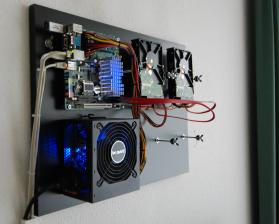

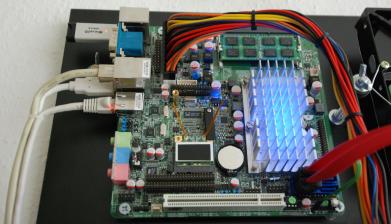
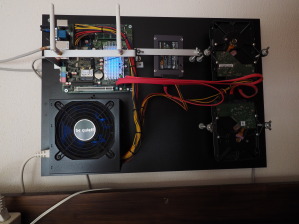
Contrary to off-the-shelf Wifi routers this server has much more powerful hardware and runs a complete distribution instead of a
crippled shell such as a busybox (if you are lucky). Both mainboard and PSU have been "pimped" with a blue LED. Two LEDs have been
connected to the DTR and RTS lines of the RS-232 header for /dev/ttyS1 to indicate if there is E-mail using a small python script.
Fedora became less attractive in time (systemd pain was a factor) so I decided to switch to Ubuntu 16. An SSD was added, resulting
in a 3 disk raid1 system. At the end of 2021 one of the disks has well over 90k operational hours and it's still working perfectly:
the usual scrubbing has not caused any sector reallocations and #pending sectors is zero.
Initial hardware consisted of a VIA EPIA CL6000 with a VIA C3 CPU running at 600MHz, 512MB RAM, two 100Mb/s Ethernet interfaces, two 80GB
PATA disks, a power adapter and a small DC to ATX power conversion board. I installed FC1 (Fedora Core 1),
modified it to suit my needs including a couple of security enhancements. It ran kernels 2.4.23 up to 2.6.38.6 (I try to keep up to date
and use kernels directly from kernel.org for a couple of reasons).

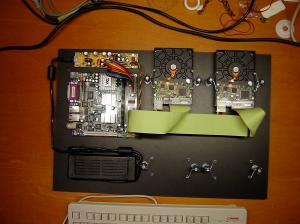
Except for the modem, all parts are mounted on a piece of black coated wood which
was originally part of some furniture. The disks are mounted a bit loosely using some
rubber rings to avoid a sounding board effect. The disks themselves have liquid bearings
which only produce a very low noise whispering like the wind and no whistle tone at all.
There's room for two more of them.
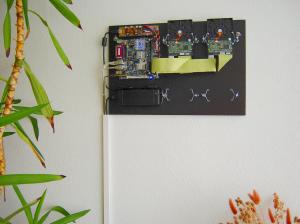
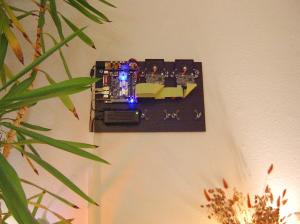
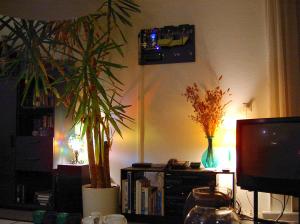
And now, let's hang it on the wall in my living room (should increase my
geekcode ;-).
The blue LED inside the (fanless) CPU cooler has been added for fun. LEDs at the bottom right of the pictures are: a blue power indicator, a red LED to indicate disk activity and a yellow LED to indicate S1 Power On Suspend state (unused because power management has been switched off). The LAN link state and activity LEDs are visible as well (had to bend the mounting barbs a bit). The red and green LEDs in the middle will blink when there is incoming mail from important people. At the bottom left there are three wires which connect another serial port to some reset logic for resetting the ADSL modem (not visible).
Those universal power adapters do not last very long as it appears: three years and two adapters later I decided to "pimp" my server with a Coolermaster Realpower 450 PSU, hoping that it would be silent and last longer. All the redundant wires from the PSU have been cut. To get rid of a (low) mechanical hum the fan screws have been removed and the fan is now kept on its place by some tiny rubber feet between fan and surroundings (everything is rather tight inside the PSU). The vibration itself is probably caused by the coils which should be driven by sinusoidal current instead of a square wave I suspect because it correlates with power, not with rpm. A spring inside the fan bearing needed some grease too and the LEDs were far too bright. By cutting the yellow wire marked "ZP" on the fan and inserting a 1k8 resistor it was fixed. Of course I removed all the sticker crap. Electronics isn't science only, it's also art!
This is how it finally looks in the living room. The server uses approximately 50W, much less than the PSU can deliver.